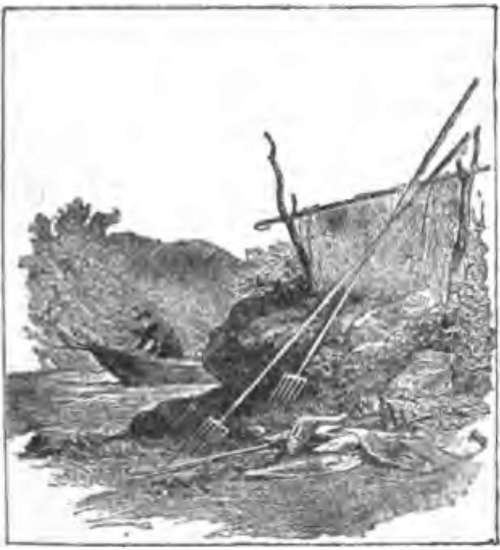The Gar-Fish (Belone)
Description
This section is from the book "Fishing", by Horace G. Hutchinson. Also available from Amazon: Fishing.
The Gar-Fish (Belone)
The gar-fish, with its near allies the saury (Hemirhamphus) and the flying fish (Exococtus), which are associated under the family Scombresocid*, represents a group of Teleosteans of the sub-order Percesoces, named P haryngognathi on account of the union of the lower pharyngeal bones, a character which we find repeated among some perches and in all the wrasses. The fins are devoid of spines, and the ventral fins are inserted far back, as in the lower Teleosteans, but the air-bladder is closed, as in the cods, perches, and other types with spines in the fins. The systematic position of the Percesocesy embracing the Scombresocids, the sand-eels (Ammodytes), the atherines, the grey mullets, and the climbing perch (Anabantida), of India and Africa, is indeed intermediate between the pike and the perches, as the name implies, and a graduated series can be formed between the two extremes.
In our gar-fish (Bclone vulgaris), the body is much elongate, feebly compressed, covered with small, thin scales; both jaws are prolonged into a long beak, bearing very numerous small, sharp teeth; the lower beak terminates in a fleshy appendage; the top of the head is quite flat and the eye perfectly lateral. The pectoral fins are short and pointed, inserted rather high up the sides; the ventral fins are inserted midway between them and the caudal fin, which is forked; the dorsal and anal fins are opposite to each other and far back. The lateral line is remarkable in being double, a second one running along each side of the belly in addition to that of the middle of the side. When fresh the gar-fish is of a beautiful sea-green or bluish-green above, paler, with iridescent hues on the sides, and silvery white beneath. The bones are green, a curious peculiarity, which in many localities causes prejudice against eating this excellent fish.
The changes which take place, with growth, in the shape of the head are very remarkable. In the young under one inch the beak is not yet developed, the snout being quite obtuse and the lower jaw a little longer; as the fish grows, the lower jaw increases in length, whilst the upper remains short, and such specimens in which the lower jaw is several times longer than the upper resemble the saury (Hemirhamphus), as a species of which they have been described.
Belone vulgaris, which grows to a length of three feet, is widely distributed on the coasts of Europe, from Iceland and Scandinavia to the Mediterranean.
It often approaches the shores in great bands, and makes itself conspicuous by its leaps over the surface of the water, shooting out almost upright, as represented in Mr. Turner-Turner's book on the " Fishes of Florida."1 Mr. J. T. Cunningham has recently ascertained that the gar-fish feeds to a great extent on the sand-eel, and he is of opinion that the proper function of the beak is to penetrate the sand in pursuit of these fish, which, as we all know, burrow in the sand by means of the projecting lower jaw. As Mr. Cunningham observes, the beak of the Belone is well adapted for probing the sand; the flexible tip of the fish's beak is doubtless a sensitive tactile organ, while the narrow toothed upper jaw is eminently fitted for seizing and holding the slippery and agile prey.
1 When thus leaping, the large species of the Tropics are said to be a source of danger to incautious fishermen, their long, sharp snout sometimes piercing the naked bodies of the savages.
The gar-fish goes by the names of sea-needle, green-bone, sword-fish, horn-eel, and gerrick, in various localities.


Continue to:
- prev: Chapter I. The Tarpons And The Gar-Fish. The Tarpons (Elopid)
- Table of Contents
- next: Chapter II. Tarpon And Other Big Fishes Of Florida
